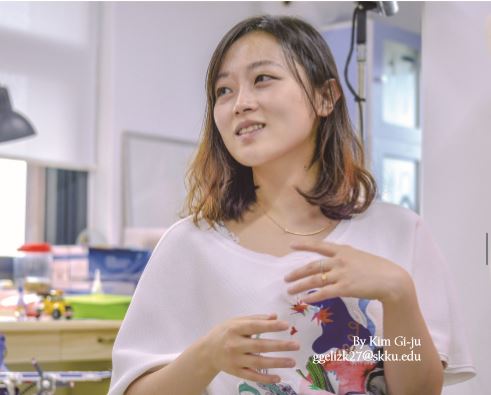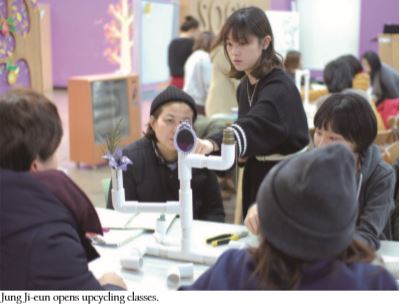The concept of upcycling, which is known to be more practical than recycling, rises, celebrating World Environment Day on June 5 th . Upcycling is a way of recycling that redesigns useless or discarded items to regenerate them into new things which have high quality and environmental values. Upcycling designer Jung Ji-eun creates and displays her works, which are made from old bikes, for sustainable upcycling design. Moreover, she has launched her shop, 2ndB, to encourage ethical consumption. Therefore, the Sungkyun Times (SKT) met upcycling designer Jung Ji-eun, who looks at used products from a fresh perspective and gives a unique role to them.

Upcycling Designer Jung Ji-eun
Q1. Please introduce yourself to the Kingos.
I am Jung Ji-eun, an upcycling designer. I make artworks and sell them through a brand called 2ndB. 2ndB means the second birth of the products. I try to look at used items from new and fresh perspectives beyond the simple conversion of their usages to capture the traces and stories that items have had.
Q2. What kinds of artworks do you make?
Upcycling design is the process of producing works with no longer used or discarded materials to give them new uses. I usually use several parts of bicycles for upcycling designs. As the bikes are always made up of the same components, I can utilize them to make similar works with consistent quality. In other words, I produce items, such as light bulbs and pencil cases, which can be created with my hands in small quantities but in the consistently high quality, from the parts of broken bicycles.

Q3. How did you start the upcycling design?
I did not know that I was upcycling at first when I started to make my works. While majoring in industrial design back at my university, I had to do my final graduation project. At that time, I was looking for interesting and unique materials for my project and found the components of bicycles. I thought making new products by disassembling existing products was practical. From this idea, I started to make artworks with discarded materials and kept working on them by getting requests for exhibitions and productions.
Q4. Why do you think the upcycling design is attractive?
I think upcycling designs are attractive because creative methods are involved in figuring out how existing items can be reassembled. For instance, a vacuum cleaner, which is made for cleaning, can be transformed into storage shelves. Similar to building blocks, the whole process of creating works is just like playing. Also, as audiences are familiar with materials, I am proud to see that they are looking at my works with amazement.

Rebirth of the Bicycle
Q5. You usually make works such as light bulbs, pencil cases and accessories with bicycles which are abandoned or no longer used. Do you have any particular reason for using bikes?
When I was a university student, I tried to use components of cars. Making works with car components, however, was difficult. It was because unused car components are hard to find as well as assemble themselves was almost impossible because many components are connected with one large hub. On the other hand, bicycles are attractive, since they are easy to find, and I can reassemble them without welding and using other devices. Moreover, since bike components can be joined in various ways, the number of possible works is infinite. Besides, there are lots of organizations, such as social enterprises and repair centers, who continuously provide components and materials for me to keep up my upcycling works. Other than bicycle components, I sometimes use other discarded items, such as plastic packages, credit card readers, and watches.
Q6. Could you explain the process of how your works are made?
If I make pencil cases, for instance, I need the wheels and tubes of bikes. In the summer season, when lots of people are riding bicycles, I find about 100 liters of dumped tubes every other day. The tubes are gathered by local government repair centers, and I collect them to cut and wash. Then I dry and sew them. After final examinations, they are transformed into pencil cases. Similarly, other works also start with cleaning the materials.

Q7. Where do you find inspiration of the artworks?
I usually get inspired by other designers’ works and movies. Mainly, I think children’s cartoon movies and fantasy movies play the most critical role in my creativity. People usually focus on actors and stories when watching films. In contrast, I focus more on backgrounds, appearances, and props of the films. Since I make visual products, I try to look for videos that are visually attractive, like advertisements. The Wheel Series. 450, which is one of the most popular artworks of mine, was inspired by the chess scene of the movie, Harry Potter. Similarly to real chess, all the light bulbs have different names, like King, Pawn, Rook, and Knight.
Q8. What do you focus on and consider most when you do upcycling design?
People usually introduce my works by saying that they are made of trash. It is true that my works are composed of discarded items. Nevertheless, I try to make my works not viewed as waste. Therefore, the biggest concern is trying to make my products in a high enough quality so that they can be seen as artworks, not trash.
Hence, I mostly focus on being as devoted to my works as possible. Although there are people who buy my products because they are upcycling products with good purposes, I think people might buy my works when they are pretty enough. Although they are upcycling work, I think the materials for the works, which are trash, also have to be refined.
Future of Jung Ji-eun and Upcycling Design
Q9. Please introduce the other activities that you do apart from upcycling design. Although I started my job by making the artworks, I thought it was hard to get closer to the general public, because in most cases, they simply see the final artworks. There are no further communications involved. Therefore, I try to make pieces of accessories to make products which are more familiar and closely related to daily life. It allowed me to diversify my product line and enabled me to launch my own shop, 2ndB.
Also, I think people these days prefer making something by themselves rather than buying completed products. One day, a company asked me to give a class about making upcycling products to its employees. I prepared upcycling kits for the class so that they could participate in making products. Then I found out that lots of people actually enjoyed it. Since then, I have kept opening the classes, which also helps to raise awareness about upcycling. Many people said they used to think that upcycling products are low-quality products, but after my class, they saw new perspectives toward upcycling. I am so proud when I hear people saying so.

Q10. Do you have any goals to achieve as an upcycling designer?
The broad goal is to keep working on my design all of my life. I am always eager to learn something new and want to widen my work spectrum by applying those learnings to my works. Unlike a master craftsman, I am not someone who keeps producing just one product. I do different activities every day. Therefore, I would like to say that I want to continue my work as an upcycling designer rather than planning the far future in detail. On the other hand, to increase awareness about upcycling, I feel that I need to expand my own business and study more about it. I am planning to study marketing and business management, as well as social enterprises which have similar business values and aims as 2ndB.
